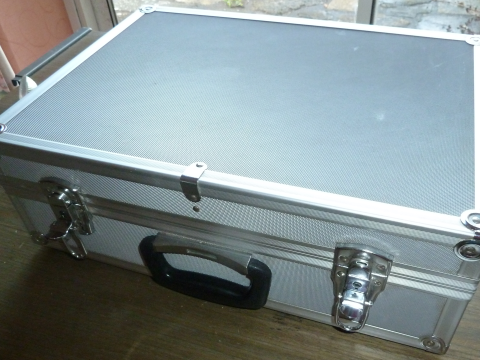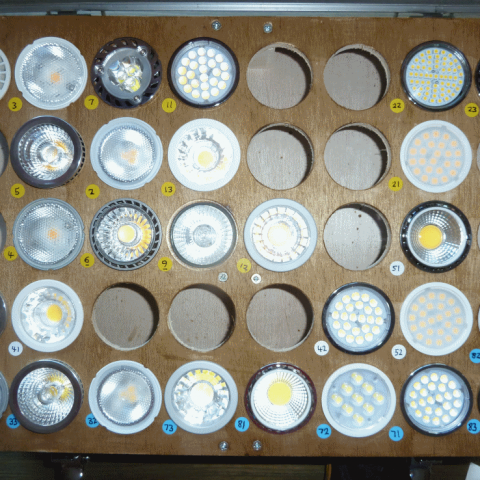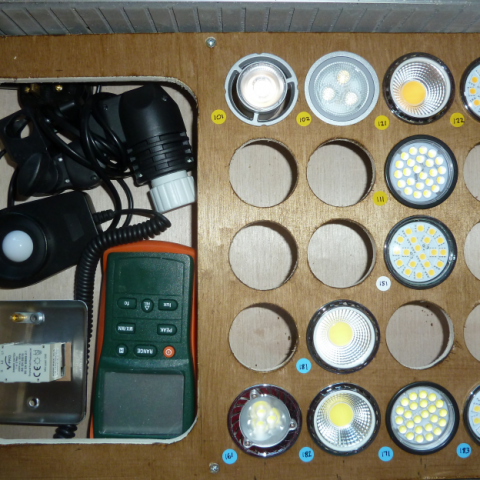Following a number of requests from other community groups about Transition Bath’s ‘try-before-you-buy’ LED lighting kit we thought it would be useful to write up some background to the project.
Why a ‘try-before-you-buy’ project?
1. Why?
- LED bulbs are about 10 times more efficient than halogens
- Because we believe from a carbon and economic perspective it is about the simplest and among the cheapest change a home-owner with halogen down-lighters in their home can make to their home to reduce carbon and save electricity costs
- Running an LED bulb for 2 hours per day will save £5 per year in electricity per bulb. Homes typically have between 10 and 30 halogen bulbs, saving between £50 and £150 per year if replaced. The LED bulbs we recommend have cost between £5 and £15 and so will pay back their capital costs in 1 to 3 years
- We thought it would reduce the barrier to get home owners to switch
2. We considered a bulk-buy scheme, but decided against because:
- there is a wide variety of LED bulbs out there which have a wide variety of specifications, not all bulbs will suit every household, how would you choose which bulbs to purchase in bulb?
- product liability issues if we resell bulbs, although we have public liability and professional indemnity insurance this would not cover the situation if we resold a batch of bulbs which failed or has electrical safety issues
- administering the scheme might also be more complicated and also potentially simpler
What does the kit consist of?
- A robust aluminium box
- An upper tray of 28 selected GU10 (mains) downlighters with a range of colours ranging from warm white to cool white, a variety of beams angles from 240 to 1200 and a variety of light outputs (lumens)
- a light meter, dimmer switch and mains plug to GU10 adaptor to help home owners test GU10 bulbs, and lots of advice both on paper and online:



The paper documentation which comes with the kit includes:
- A list of contents
- Instructions about how to use the kit
- A front sheet for the GU10s
- A ‘database’ of the GU10 bulbs and their specifications
- A front sheet for the MR16s
- A ‘database’ of the MR16s bulbs and their specifications
Online documentation (needs further work)
How did we choose what went into the kit?
- We sampled and tested a selection of LED bulbs from ebay, DIY stores and specialist online suppliers
- We took advice from people with expertise in this area
- We did lots of reading on the internet
- Bulb selection:
- Ebay: we decided against recommending any ebay bulbs, although they were generally cheaper:
- They rarely met their specifications i.e. colours, lumens, beams angles were generally poor
- Many don’t come with guarantees
- Because there is so much turn over in the market it is hard to provide links to bulbs which are still available, many bulbs we bought 3 months ago are now no longer available, so we would have to keep changing the kit
- Some ebay bulbs are electrically unsafe
- DIY stores: their bulbs are generally under-powered, expensive and give LED bulbs a bad reputation. We do include one example in the kit from Homebase, but generally just to prove this point. They also don;t come with long guarantees
- Specialist online stores: we feel these are the best places to purchase bulbs from:
- they offer good value and their bulbs meet their specifications most of the time
- they offer good value, typically with 5 years guarantee (a specified 25,000hours life is no use if a whole batch fails which can happen)
- they offer good support and documentation online
- they offer choice
- they offer Transition Bath a 10% cut of any purchases made through the scheme, which we are hoping will cover the costs of building the kit
- Ebay: we decided against recommending any ebay bulbs, although they were generally cheaper:
- The other components of the kit, including a light meter, the most compatible dimmer on the market, a GU10 to mains adaptor are included in the kit to help home owners make their decisions
How does the loan of the kit work?
The kit will be loaned out via Bath Central Library. We have agreement from the library but as of 20 Oct 2014 we are still awaiting a final meeting with the library to confirm final details of the cataloguing of the kit. More details will appear here once the final meeting has taken place.
The kit will be available on loan for 1 week to members of the public and will be secured on a library card.
How did we go about constructing the kit and how much did it cost to build?
This design is effectively our second design. The redesigned kit has been constructed to be very robust because it will be on loan from the library and we don’t want to spend out time repairing it! Clearly this design is not unique and there are many other ways of constructing such a kit:
1. Aluminium box: available on ebay for £30, has to be correct size to hold 2 trays with up to 80mm deep bulbs
2. 2 x 9mm plywood trays costs £15, plus about 5 hours labour to cut 60 46mm holes and other inserts, plus robust 2nd generation supporting structure (design and possible loan of hole saws available on request from other community groups). There are more holes than bulbs to allow the bulbs to be laid out in a grid of colour temperature versus beam angle to make choosing bulbs easier
3. about 40 bulbs, all supplied free as samples from the 4 online stores we selected
3. light meter: £60, the one we are currently using was specially selected for this application following consultation with the manufacturer. We previously used a £20 example from ebay but found it to be very poor measuring LUX at the warmer end of the spectrum – we would avise against using a cheap one.
4. LED compatible dimmer switch (£15), GU10 to mains adaptor (£6)
Other information
- we took time to select the online stores which we felt provided good advice, a good selection of bulbs, were prepared to work with us, supply samples, a 10% cut and had long typically 5 year guarantees to their bulbs
- we chose 4 online suppliers as a charity we didn’t want to endorse just one supplier
- we tested about 80 bulbs deciding to go with these online suppliers
- the project hasn’t really started yet so we can’t really provide solid feedback. We are not aware of any other similar scheme in the UK, please let us know if you find one
- we would advise not focussing on comparing the relative efficiencies of individual LED bulbs, as they are all 7 to 12 times more efficient than halogens, the most important thing is to get people to switch to something they like and would recommend to others
- we are happy to work with other community groups if they want to setup similar projects we have already (20/10/2014) had a number of enquiries (hence this webpage). We would hope to have more concrete feedback by January 2015 at which point we would be very happy to share contact details of our suppliers with you – we are assuming the project will be a success by then and therefore suppliers would be happy to work with you
- we have had an online form for a few months which we have been using to collect contact details of people who have expressed interest, we have been trailing the scheme via out newsletter and Bath Green Homes. We significant interest from individuals in borrowing the kit and have had enquiries
- we have had enquiries from libraries saying they have been approached by individuals asking about the scheme and when the kit is going to be available
- given the current interest, we are expecting to construct perhaps 2 to 3 more copies of the kit from January for other local libraries and perhaps a 2nd one for Bath Central Library if the kit proves too popular
- we are considering another kit containing non-downlighter bulbs – i.e. standard bayonet fit lighting, candle bulbs, LED strips, LED arrays, but although there appears to be demand, we felt that this kit would be more challenging to construct because of the potential explosion in combinations of bulbs and suppliers. We also feel people generally have many more identical GU10 and MR16 downlighters in their homes than the other varieties so the carbon benefits of starting with GU10/MR16s would be much greater?